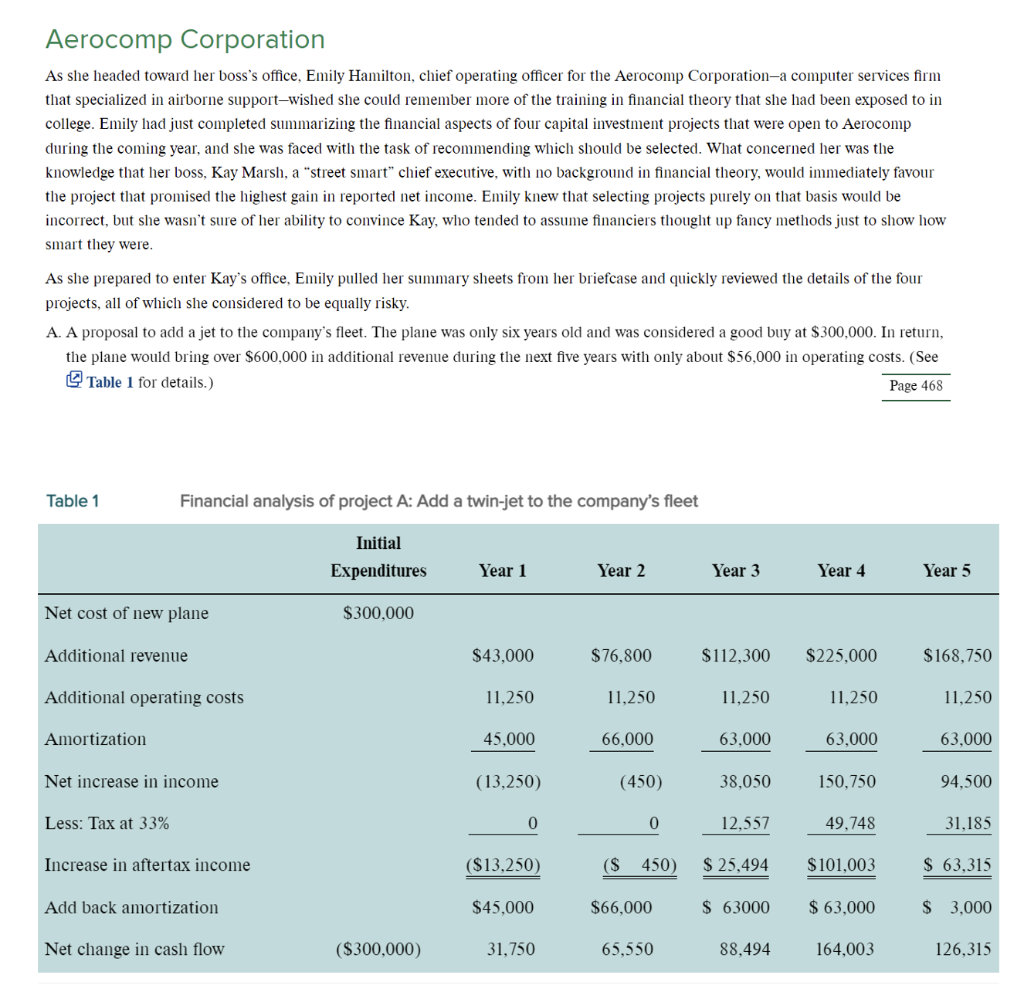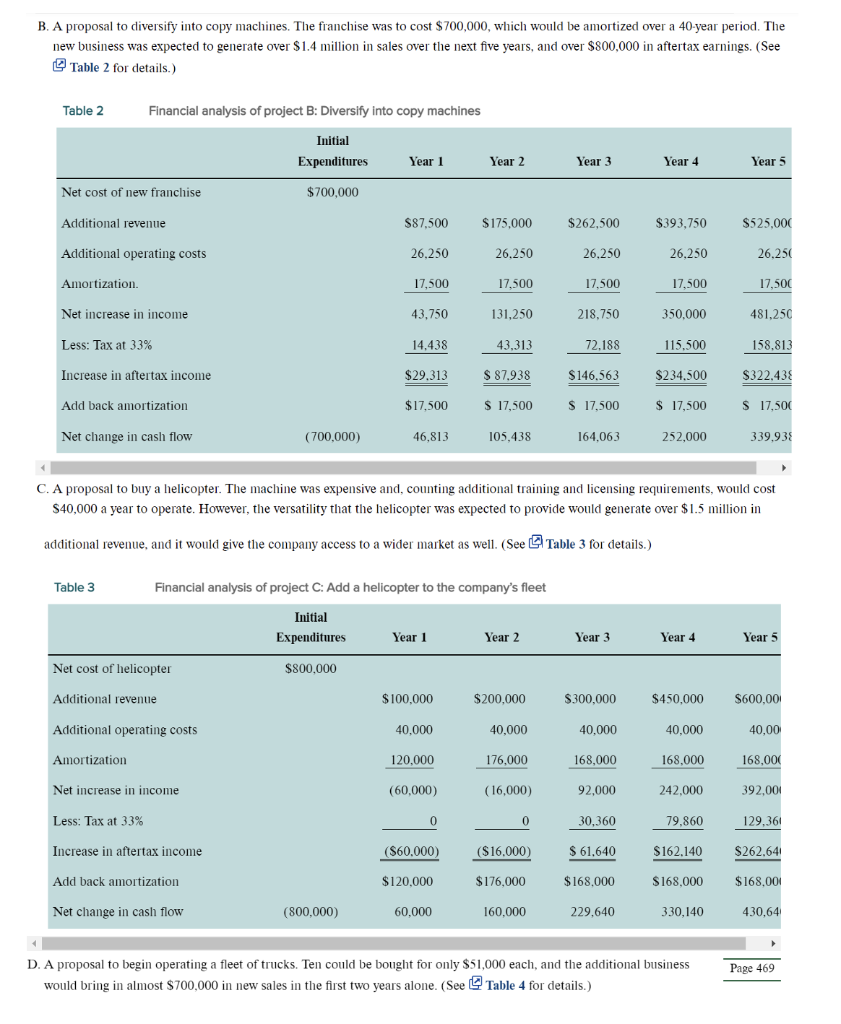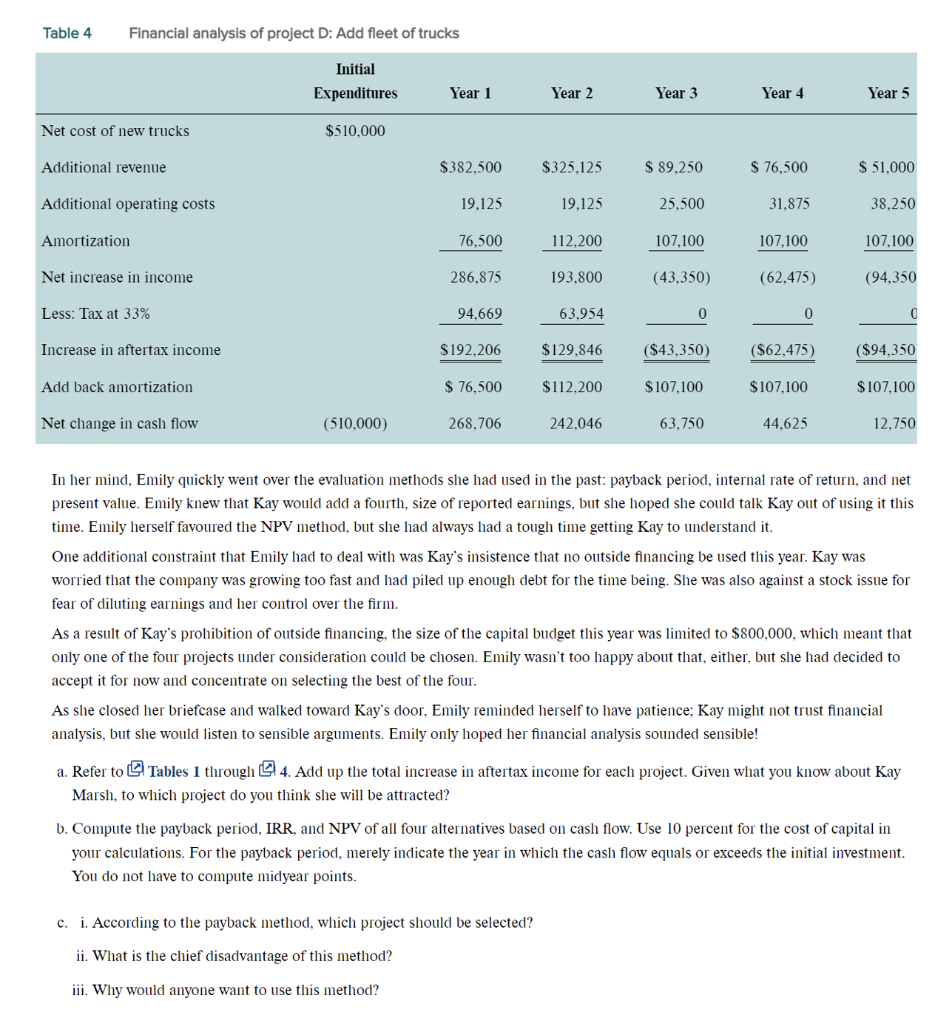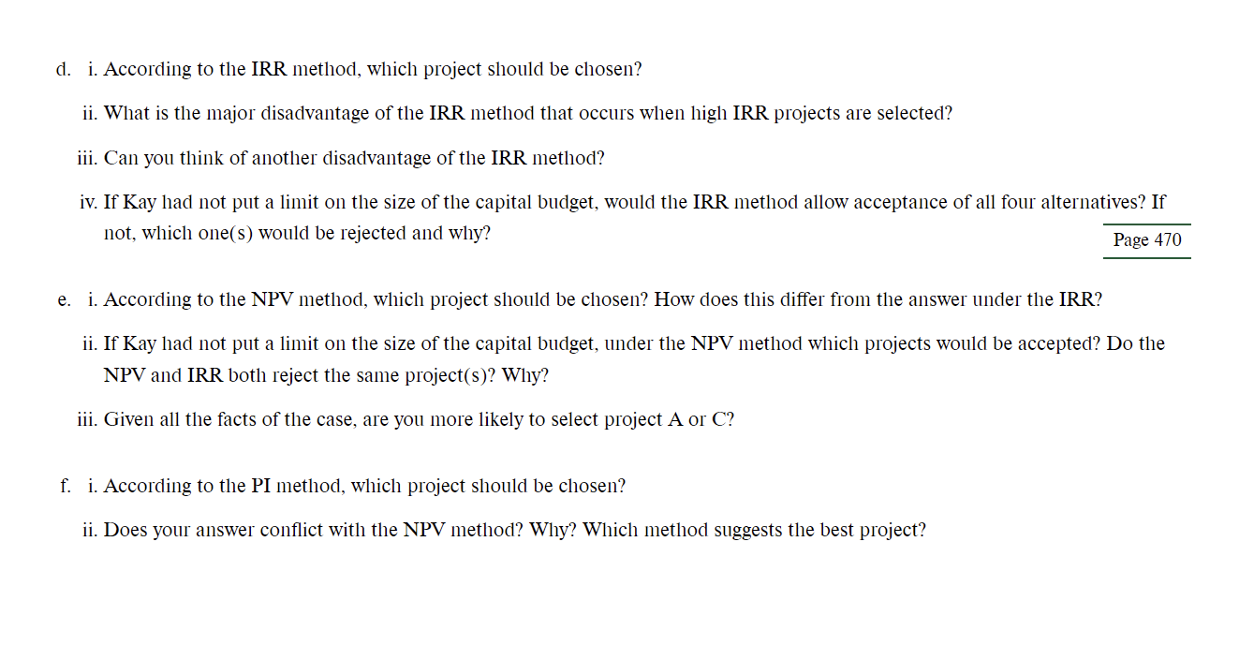Answered step by step
Verified Expert Solution
Question
1 Approved Answer
PLEASE HELP PLEASE HELP Aerocomp Corporation As she headed toward her boss's office, Emily Hamilton, chief operating officer for the Aerocomp Corporation-a computer services firm
PLEASE HELP




PLEASE HELP
Aerocomp Corporation As she headed toward her boss's office, Emily Hamilton, chief operating officer for the Aerocomp Corporation-a computer services firm that specialized in airborne support-wished she could remember more of the training in financial theory that she had been exposed to in college. Emily had just completed summarizing the financial aspects of four capital investment projects that were open to Aerocomp during the coming year, and she was faced with the task of recommending which should be selected. What concerned her was the knowledge that her boss, Kay Marsh, a "street smart" chief executive, with no background in financial theory, would immediately favour the project that promised the highest gain in reported net income. Emily knew that selecting projects purely on that basis would be incorrect, but she wasn't sure of her ability to convince Kay, who tended to assume financiers thought up fancy methods just to show how smart they were. As she prepared to enter Kay's office, Emily pulled her summary sheets from her briefcase and quickly reviewed the details of the four projects, all of which she considered to be equally risky. A. A proposal to add a jet to the company's fleet. The plane was only six years old and was considered a good buy at $300,000. In return, the plane would bring over $600,000 in additional revenue during the next five years with only about $56,000 in operating costs. (See Table 1 for details.) Page 468 Table 1 Financial analysis of project A: Add a twin-jet to the company's fleet Initial Expenditures Year 1 Year 2 Year 3 Year 4 Year 5 Net cost of new plane $300,000 Additional revenue $43,000 $76,800 $112,300 $225,000 $168,750 Additional operating costs 11,250 11,250 11,250 11,250 11,250 Amortization 45,000 66,000 63,000 63,000 63.000 Net increase in income (13,250) (450) 38,050 150,750 94,500 Less: Tax at 33% 0 0 12,557 49,748 31,185 Increase in aftertax income ($13,250) ($ 450) $ 25,494 $ 101,003 $ 63,315 Add back amortization $45,000 $66,000 $ 63000 $ 63,000 $ 3,000 Net change in cash flow ($300,000) 31,750 65,550 88,494 164,003 126,315 B. A proposal to diversify into copy machines. The franchise was to cost $ 700,000, which would be amortized over a 40-year period. The new business was expected to generate over $1.4 million in sales over the next five years, and over $800,000 in aftertax earnings. (See Table 2 for details.) Table 2 Financial analysis of project B: Diversify into copy machines Initial Expenditures Year 1 Year 2 Year 3 Year 4 Year 5 Net cost of new franchise $700,000 Additional revenue $87.500 $175,000 $262,500 $393,750 $525.000 Additional operating costs 26.250 26.250 26.250 26.250 26.250 Amortization. 17,500 17,500 17.500 17,500 17,500 Net increase in income 43,750 131,250 218.750 350,000 481,250 Less: Tax at 33% 14.438 43,313 72.188 115.500 158.813 Increase in aftertax income $29.313 $ 87,938 $146.563 $234.500 $322.43 Add back amortization $17,500 $ 17,500 $ 17,500 $ 17,500 $ 17,500 Net change in cash flow (700,000) 46,813 105.438 164,063 252,000 339.938 C. A proposal to buy a helicopter. The machine was expensive and, counting additional training and licensing requirements, would cost $40,000 a year to operate. However, the versatility that the helicopter was expected to provide would generate over $1.5 million in additional revenue, and it would give the company access to a wider market as well. (See Table 3 for details.) Table 3 Financial analysis of project C: Add a helicopter to the company's fleet Initial Expenditures Year 1 Year 2 Year 3 3 Year 4 Year 5 Net cost of helicopter $800.000 Additional revenue $100,000 $200.000 $300,000 $450,000 $600,00 Additional operating costs 40,000 40.000 40,000 40,000 40,00 Amortization 120.000 176,000 168,000 168,000 168,000 Net increase in income (60,000) (16,000) 92,000 242.000 392,000 Less: Tax at 33% 0 0 30,360 79.860 129,361 Increase in aftertax income ($60.000) ($16.000) $ 61,640 $162.140 $262.64 Add back amortization $120,000 $176,000 $168.000 $ 168,000 $ 168,00 Net change in cash flow (800,000) 60,000 160,000 229,640 330,140 430,64 Page 469 D. A proposal to begin operating a fleet of trucks. Ten could be bought for only $51,000 each, and the additional business would bring in almost $700,000 in new sales in the first two years alone. (See Table 4 for details.) Table 4 Financial analysis of project D: Add fleet of trucks Initial Expenditures Year 1 Year 2 Year 3 Year 4 Year 5 Net cost of new trucks $510,000 Additional revenue $382,500 $325,125 $ 89,250 $ 76,500 $ 51,000 Additional operating costs 19,125 19,125 25,500 31,875 38,250 Amortization 76,500 112,200 107,100 107,100 107,100 Net increase in income 286,875 193.800 (43,350) (62,475) (94,350 Less: Tax at 33% 94,669 63.954 0 0 Increase in aftertax income $ 192,206 $129,846 ($43,350) ($62,475) ($94,350 Add back amortization $ 76,500 $112,200 $ 107,100 $ 107,100 $ 107,100 Net change in cash flow (510,000) 268,706 242,046 63,750 44,625 12,750 In her mind, Emily quickly went over the evaluation methods she had used in the past: payback period, internal rate of return, and net present value. Emily knew that Kay would add a fourth, size of reported earnings, but she hoped she could talk Kay out of using it this time. Emily herself favoured the NPV method, but she had always had a tough time getting Kay to understand it. One additional constraint that Emily had to deal with was Kay's insistence that no outside financing be used this year. Kay was worried that the company was growing too fast and had piled up enough debt for the time being. She was also against a stock issue for fear of diluting earnings and her control over the firm. As a result of Kay's prohibition of outside financing, the size of the capital budget this year was limited to $800,000, which meant that only one of the four projects under consideration could be chosen. Emily wasn't too happy about that, either, but she had decided to accept it for now and concentrate on selecting the best of the four. As she closed her briefcase and walked toward Kay's door, Emily reminded herself to have patience; Kay might not trust financial analysis, but she would listen to sensible arguments. Emily only hoped her financial analysis sounded sensible! a. Refer to Tables 1 through 4. Add up the total increase in aftertax income for each project. Given what you know about Kay Marsh, to which project do you think she will be attracted? b. Compute the payback period, IRR, and NPV of all four alternatives based on cash flow. Use 10 percent for the cost of capital in your calculations. For the payback period, merely indicate the year in which the cash flow equals or exceeds the initial investment. You do not have to compute midyear points. c. i. According to the payback method, which project should be selected? ii. What is the chief disadvantage of this method? iii. Why would anyone want to use this method? d. i. According to the IRR method, which project should be chosen? ii. What is the major disadvantage of the IRR method that occurs when high IRR projects are selected? iii. Can you think of another disadvantage of the IRR method? iv. If Kay had not put a limit on the size of the capital budget, would the IRR method allow acceptance of all four alternatives? If not, which one(s) would be rejected and why? Page 470 e. i. According to the NPV method, which project should be chosen? How does this differ from the answer under the IRR? ii. If Kay had not put a limit on the size of the capital budget, under the NPV method which projects would be accepted? Do the NPV and IRR both reject the same project(s)? Why? iii. Given all the facts of the case, are you more likely to select project A or C? f. i. According to the PI method, which project should be chosen? ii. Does your answer conflict with the NPV method? Why? Which method suggests the best project? Aerocomp Corporation As she headed toward her boss's office, Emily Hamilton, chief operating officer for the Aerocomp Corporation-a computer services firm that specialized in airborne support-wished she could remember more of the training in financial theory that she had been exposed to in college. Emily had just completed summarizing the financial aspects of four capital investment projects that were open to Aerocomp during the coming year, and she was faced with the task of recommending which should be selected. What concerned her was the knowledge that her boss, Kay Marsh, a "street smart" chief executive, with no background in financial theory, would immediately favour the project that promised the highest gain in reported net income. Emily knew that selecting projects purely on that basis would be incorrect, but she wasn't sure of her ability to convince Kay, who tended to assume financiers thought up fancy methods just to show how smart they were. As she prepared to enter Kay's office, Emily pulled her summary sheets from her briefcase and quickly reviewed the details of the four projects, all of which she considered to be equally risky. A. A proposal to add a jet to the company's fleet. The plane was only six years old and was considered a good buy at $300,000. In return, the plane would bring over $600,000 in additional revenue during the next five years with only about $56,000 in operating costs. (See Table 1 for details.) Page 468 Table 1 Financial analysis of project A: Add a twin-jet to the company's fleet Initial Expenditures Year 1 Year 2 Year 3 Year 4 Year 5 Net cost of new plane $300,000 Additional revenue $43,000 $76,800 $112,300 $225,000 $168,750 Additional operating costs 11,250 11,250 11,250 11,250 11,250 Amortization 45,000 66,000 63,000 63,000 63.000 Net increase in income (13,250) (450) 38,050 150,750 94,500 Less: Tax at 33% 0 0 12,557 49,748 31,185 Increase in aftertax income ($13,250) ($ 450) $ 25,494 $ 101,003 $ 63,315 Add back amortization $45,000 $66,000 $ 63000 $ 63,000 $ 3,000 Net change in cash flow ($300,000) 31,750 65,550 88,494 164,003 126,315 B. A proposal to diversify into copy machines. The franchise was to cost $ 700,000, which would be amortized over a 40-year period. The new business was expected to generate over $1.4 million in sales over the next five years, and over $800,000 in aftertax earnings. (See Table 2 for details.) Table 2 Financial analysis of project B: Diversify into copy machines Initial Expenditures Year 1 Year 2 Year 3 Year 4 Year 5 Net cost of new franchise $700,000 Additional revenue $87.500 $175,000 $262,500 $393,750 $525.000 Additional operating costs 26.250 26.250 26.250 26.250 26.250 Amortization. 17,500 17,500 17.500 17,500 17,500 Net increase in income 43,750 131,250 218.750 350,000 481,250 Less: Tax at 33% 14.438 43,313 72.188 115.500 158.813 Increase in aftertax income $29.313 $ 87,938 $146.563 $234.500 $322.43 Add back amortization $17,500 $ 17,500 $ 17,500 $ 17,500 $ 17,500 Net change in cash flow (700,000) 46,813 105.438 164,063 252,000 339.938 C. A proposal to buy a helicopter. The machine was expensive and, counting additional training and licensing requirements, would cost $40,000 a year to operate. However, the versatility that the helicopter was expected to provide would generate over $1.5 million in additional revenue, and it would give the company access to a wider market as well. (See Table 3 for details.) Table 3 Financial analysis of project C: Add a helicopter to the company's fleet Initial Expenditures Year 1 Year 2 Year 3 3 Year 4 Year 5 Net cost of helicopter $800.000 Additional revenue $100,000 $200.000 $300,000 $450,000 $600,00 Additional operating costs 40,000 40.000 40,000 40,000 40,00 Amortization 120.000 176,000 168,000 168,000 168,000 Net increase in income (60,000) (16,000) 92,000 242.000 392,000 Less: Tax at 33% 0 0 30,360 79.860 129,361 Increase in aftertax income ($60.000) ($16.000) $ 61,640 $162.140 $262.64 Add back amortization $120,000 $176,000 $168.000 $ 168,000 $ 168,00 Net change in cash flow (800,000) 60,000 160,000 229,640 330,140 430,64 Page 469 D. A proposal to begin operating a fleet of trucks. Ten could be bought for only $51,000 each, and the additional business would bring in almost $700,000 in new sales in the first two years alone. (See Table 4 for details.) Table 4 Financial analysis of project D: Add fleet of trucks Initial Expenditures Year 1 Year 2 Year 3 Year 4 Year 5 Net cost of new trucks $510,000 Additional revenue $382,500 $325,125 $ 89,250 $ 76,500 $ 51,000 Additional operating costs 19,125 19,125 25,500 31,875 38,250 Amortization 76,500 112,200 107,100 107,100 107,100 Net increase in income 286,875 193.800 (43,350) (62,475) (94,350 Less: Tax at 33% 94,669 63.954 0 0 Increase in aftertax income $ 192,206 $129,846 ($43,350) ($62,475) ($94,350 Add back amortization $ 76,500 $112,200 $ 107,100 $ 107,100 $ 107,100 Net change in cash flow (510,000) 268,706 242,046 63,750 44,625 12,750 In her mind, Emily quickly went over the evaluation methods she had used in the past: payback period, internal rate of return, and net present value. Emily knew that Kay would add a fourth, size of reported earnings, but she hoped she could talk Kay out of using it this time. Emily herself favoured the NPV method, but she had always had a tough time getting Kay to understand it. One additional constraint that Emily had to deal with was Kay's insistence that no outside financing be used this year. Kay was worried that the company was growing too fast and had piled up enough debt for the time being. She was also against a stock issue for fear of diluting earnings and her control over the firm. As a result of Kay's prohibition of outside financing, the size of the capital budget this year was limited to $800,000, which meant that only one of the four projects under consideration could be chosen. Emily wasn't too happy about that, either, but she had decided to accept it for now and concentrate on selecting the best of the four. As she closed her briefcase and walked toward Kay's door, Emily reminded herself to have patience; Kay might not trust financial analysis, but she would listen to sensible arguments. Emily only hoped her financial analysis sounded sensible! a. Refer to Tables 1 through 4. Add up the total increase in aftertax income for each project. Given what you know about Kay Marsh, to which project do you think she will be attracted? b. Compute the payback period, IRR, and NPV of all four alternatives based on cash flow. Use 10 percent for the cost of capital in your calculations. For the payback period, merely indicate the year in which the cash flow equals or exceeds the initial investment. You do not have to compute midyear points. c. i. According to the payback method, which project should be selected? ii. What is the chief disadvantage of this method? iii. Why would anyone want to use this method? d. i. According to the IRR method, which project should be chosen? ii. What is the major disadvantage of the IRR method that occurs when high IRR projects are selected? iii. Can you think of another disadvantage of the IRR method? iv. If Kay had not put a limit on the size of the capital budget, would the IRR method allow acceptance of all four alternatives? If not, which one(s) would be rejected and why? Page 470 e. i. According to the NPV method, which project should be chosen? How does this differ from the answer under the IRR? ii. If Kay had not put a limit on the size of the capital budget, under the NPV method which projects would be accepted? Do the NPV and IRR both reject the same project(s)? Why? iii. Given all the facts of the case, are you more likely to select project A or C? f. i. According to the PI method, which project should be chosen? ii. Does your answer conflict with the NPV method? Why? Which method suggests the best projectStep by Step Solution
There are 3 Steps involved in it
Step: 1

Get Instant Access to Expert-Tailored Solutions
See step-by-step solutions with expert insights and AI powered tools for academic success
Step: 2

Step: 3

Ace Your Homework with AI
Get the answers you need in no time with our AI-driven, step-by-step assistance
Get Started


